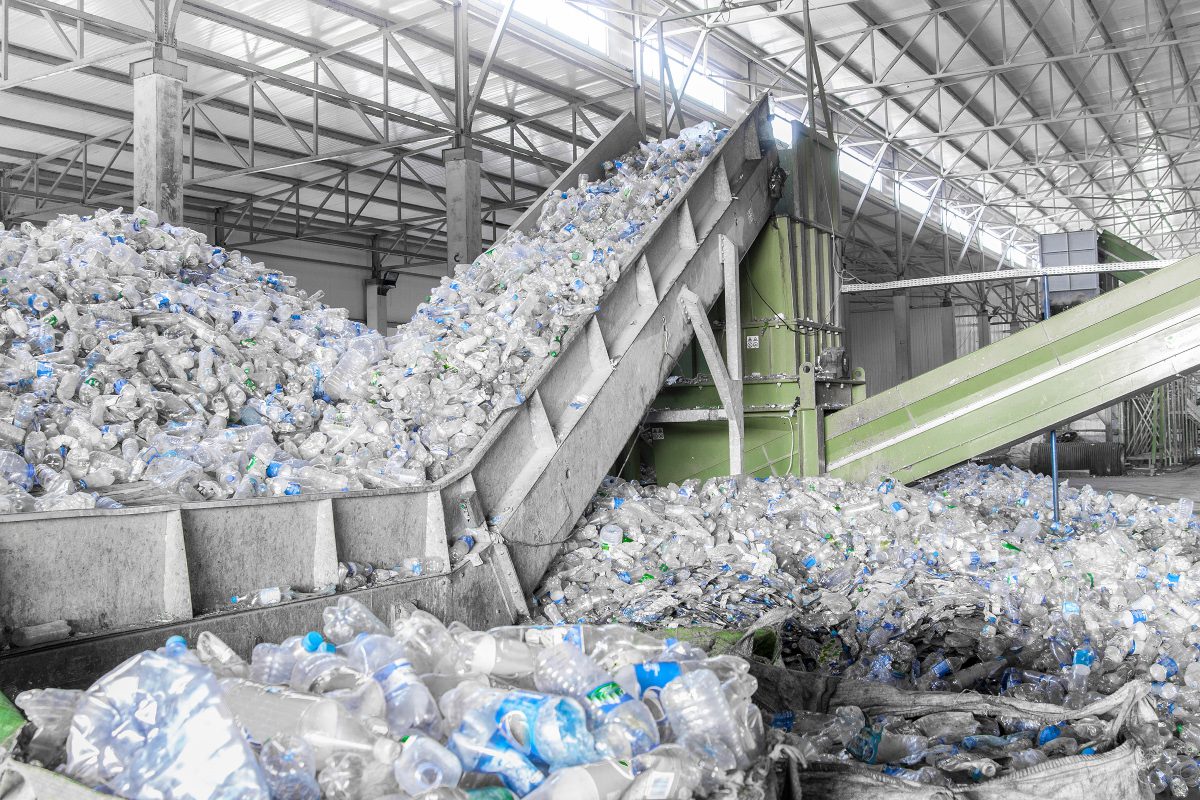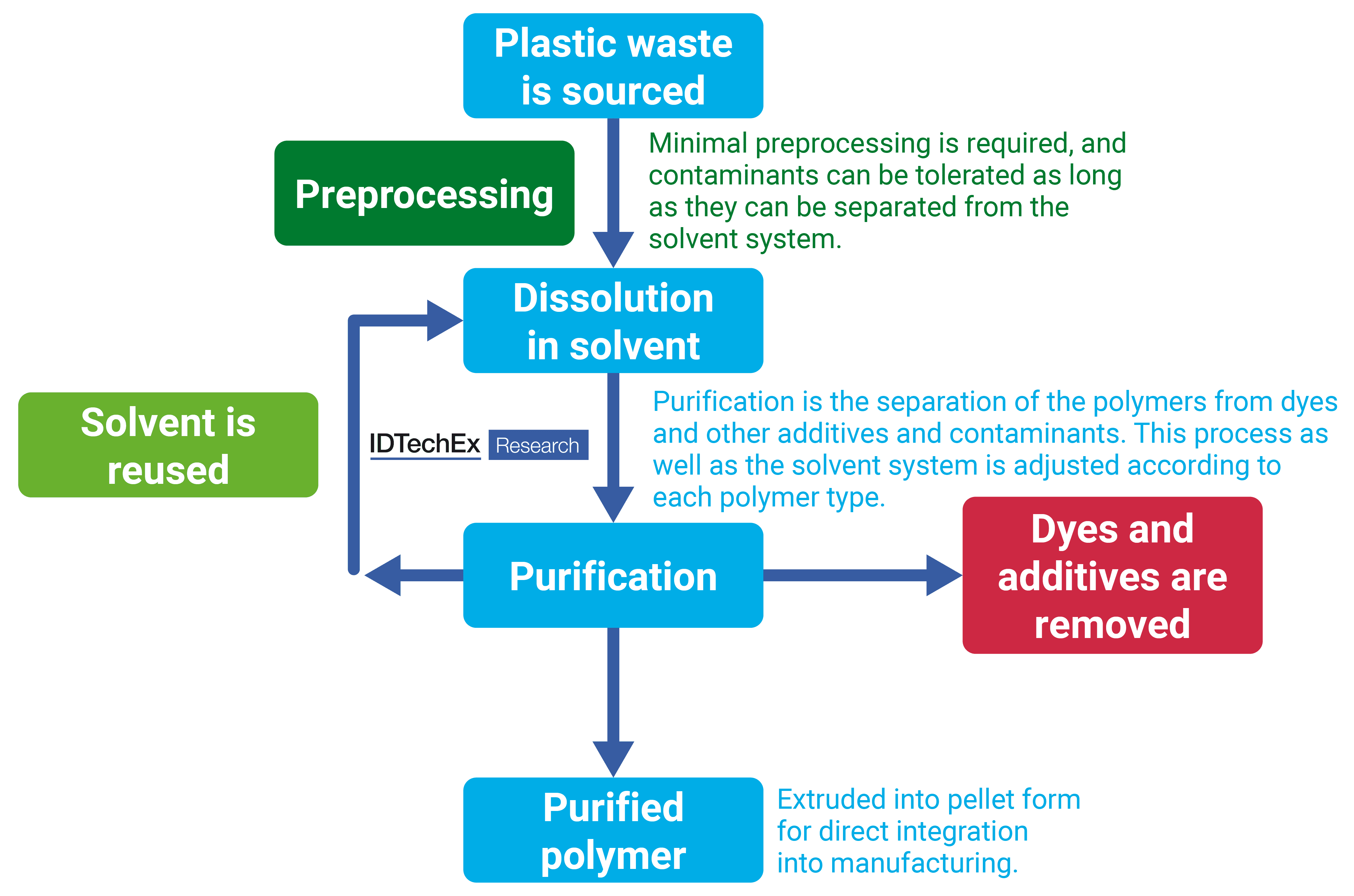
By James Kennedy, a technology analyst at market intelligence firm IDTechEx.
The advanced recycling market for plastics predominantly focuses on technologies like pyrolysis and depolymerization (thermal, chemical, and enzymatic). To a lesser extent, methods such as gasification and hydrothermal liquefaction are also being explored. However, these technologies face increasing scrutiny and restrictions in some regions due to their environmental impact. However, while mechanical recycling is the preferred recycling method due to its cost-effectiveness and efficiency, it still falls short in applications requiring high purity and mechanical properties. To address these challenges posed by both chemical recycling technologies and mechanical recycling, dissolution technologies (sometimes referred to as solvent extraction) offer a promising solution.
Dissolution explained
Dissolution involves separating polymer waste using a solvent. The solvent selectively dissolves the polymer, separating it from contaminants and other non-target materials. Once dissolved, the solution is purified, and the solvent is removed, leaving behind a nearly pure plastic that can be processed back into granules for reuse in manufacturing.
This method can deal with contaminated or mixed plastic waste that is challenging to recycle through mechanical means while not breaking the polymers into their constituent molecules or feedstock. The need to carefully separate different polymer types is reduced, as plastic types can be selectively dissolved and separated out when using the correct solvent mixture. The processes are designed with solvents and separation methods for specific plastic types such as polypropylene, polystyrene, and acrylonitrile butadiene styrene.
PureCycle Technologies is a notable player in the field of plastic dissolution. The company utilizes a proprietary technology developed by Procter & Gamble to recycle polypropylene. Its process involves using a solvent (primarily n-butane) to purify waste polypropylene into a form that is comparable in quality to virgin plastic. PureCycle states that its recycled PP can be used in applications where mechanical recycling methods, such as food-grade packaging, would not suffice. PureCycle is currently the leading commercial-scale provider in this space.
The key advantage of dissolution is the higher theoretical overall yield that it can provide compared to chemical recycling technologies, as the product re-enters the plastic supply chain as a ready-for-use resin rather than simply a polymer building block or a hydrocarbon.
As a relatively nascent industry, there is continuing R&D on its processes. One standout is Solvent-Targeted Recovery and Precipitation (STRAP), which is a new technology framework that researchers at the University of Wisconsin-Madison have developed. The technology can separate the components of multilayer plastic films and remove contaminants. Multilayer films are a key challenge in plastic waste management, and as a result, the commercialization of this technology has strong potential. Additionally, the developers of STRAP claim the process has many advantages over competitors, including operation at atmospheric pressure and lower temperatures. At present, a STRAP pilot plant is being built at Michigan Tech University to prove the technology. The promise of a highly adaptable dissolution system for this type of hard-to-recycle plastic waste would be the most sought-after solution. The technical challenges of scaling STRAP will likely mean several years before this is at a commercial scale.
The general process for the dissolution of plastic waste (source: IDTechX). Click image to enlarge.
Dissolution drawbacks
While dissolution technology holds promise, it is not without its challenges and criticisms. For example, there are questions about long-term circularity as the polymer is likely to degrade over successive cycling. Another concern with the dissolution process is the environmental impact of the solvents used. These chemicals must be managed carefully to avoid releasing harmful substances into the environment. The energy required to heat the solvents and subsequently remove them from the dissolved plastic also adds to the carbon footprint of the process.
The economic viability of dissolution technology also remains uncertain. The cost of the solvents, energy consumption, and the need for sophisticated infrastructure will likely make recycled polymers from dissolution plants more expensive than with mechanical recycling methods. The size of this green premium versus other recycling technologies will determine whether dissolution plants can be economically viable.
Furthermore, the scale required to make a significant impact on plastic waste through dissolution is immense. Building the necessary infrastructure to process large volumes of plastic waste through dissolution is a massive undertaking that will require substantial capital investment and time.
The success of dissolution technologies like PureCycle’s depends on market demand for recycled plastics. While there is growing interest in sustainable materials, competition from cheaper, virgin plastics can limit the market potential for recycled products. Future efforts will focus on developing processes for a wider range of polymer types. Companies such as APK, Worn Again, and Polystyvert are working with polyethylene (PE), polyethylene terephthalate (PET), and polystyrene (PS), respectively. The Netherlands Organization for Applied Scientific Research (TNO) is developing a process called Mobius for recycling acrylonitrile butadiene styrene (ABS), though it is not yet commercialized.
Dissolution presents a promising technology for addressing the demand for low-carbon, versatile plastic waste solutions. However, several hurdles remain, including technological refinement, commercial scaling, and economic challenges. Stakeholders must carefully evaluate the benefits and drawbacks of dissolution within the broader context of global waste management strategies. Navigating economic challenges will be key, as price will be the determinant factor in success as companies adopting recycled polymers evaluate how much of a green premium they can afford. Continued research, investment, and regulatory support will be essential to refine the process and assess its long-term viability as part of a comprehensive effort to mitigate the impact of plastic waste on the environment.







